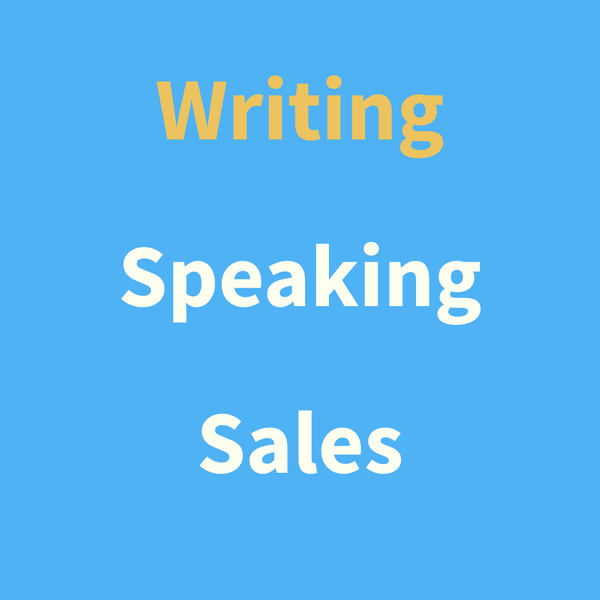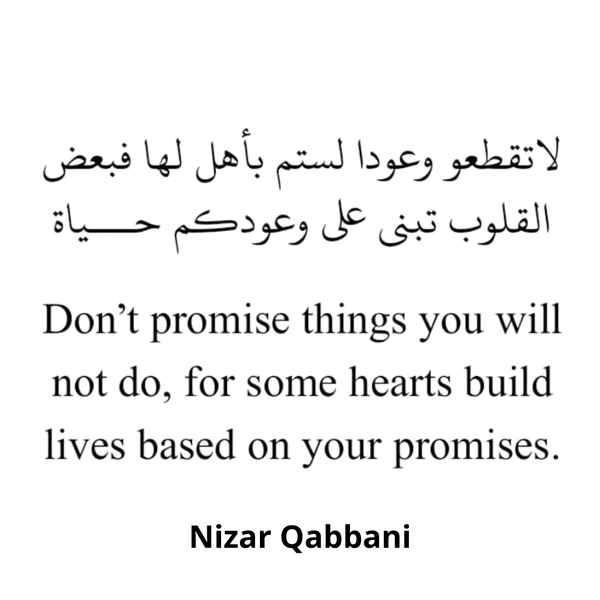17 Lesson From Sending 22,834,311 Emails and Making $1.35M in Sales
An email marketing guide with 17 Lesson From Sending 22,834,311 Emails and Making $1.35M in Sales for a US supplements company
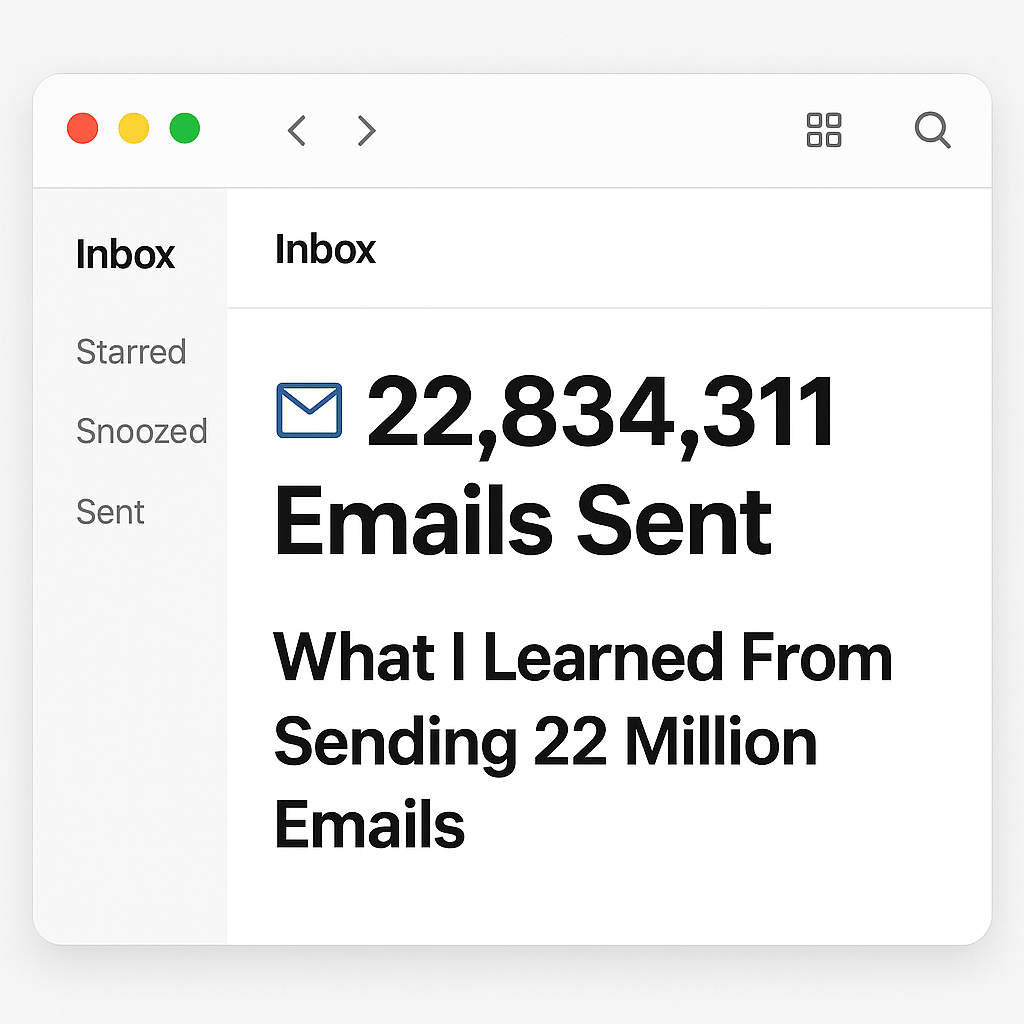
In 2022, I started managing email for a US supplements brand.
Since then, I’ve sent 22,834,311 emails and generated $1,358,936.10 in revenue, all measured on a strict 24-hour attribution window (no inflated numbers, no tricks).
That matters, because most marketers stretch attribution to 3–5 days to make results look bigger. We didn’t. This case study is built on real, honest data.
Along the way, I saw what works (flows, segmentation, testing) and what doesn’t (deliverability slips, junk list growth, weak subject lines). More importantly, I learned how small tweaks, made consistently, compound into big wins.
This post breaks down 17 lessons from 22 million emails:
- The foundations every program needs
- The hard truths no copywriting trick can cover up
- The tactics that separate average brands from great ones
Each lesson ends with a “5-Minute Fix” ,a simple, actionable step you can implement today.
Because most brands don’t need a total overhaul.
They just need the right small changes, applied consistently.
Here’s the roadmap.
Basic Lessons (The Foundations)
The essentials every program needs to start driving consistent revenue.
- Email More, Make More – why frequency is the #1 growth lever.
- Flows Are Gold – how automation quietly drives half your revenue.
- Grow Your List the Right Way – the difference between subscribers and buyers.
- Test Everything – how small A/B tests compound into massive wins.
Intermediate Lessons (The Next Level)
Tactics that separate average brands from great ones.
- Sell the Click, Not the Product – the real job of your email.
- Click Rate Is King – the metric that makes or breaks deliverability.
- Sequence Matters – why order (emotion → proof → logic → CTA) changes everything.
- Know Your Customer for Real – psychographics beat demographics every time.
- Segmentation Is Everything – how to send smarter, not louder.
- Benchmark Against the Best – why your customer sees more than just your emails.
Advanced Lessons (The Hard Truths)
The uncomfortable realities that no copy trick can cover up.
- Attribution Is Fragile – why most reported revenue numbers are inflated.
- Deliverability Can Kill You – the invisible factor that tanks sales overnight.
- CRO Matters as Much as Copy – what to fix when clicks don’t turn into sales.
- Promotions ≠ Discounts – smarter ways to drive sales without killing margins.
- Coupons Still Work – the psychology of “winning” a deal.
- Be Intentional About Frequency – how to email more without burning your list.
- Sometimes the Product Is the Problem – the hardest truth in marketing.
Need help with your email strategy? Hop on a free consultation call.
Basic Lessons (The Foundations)
Using email to get consistent revenue.
#1 Email More, Make More
When I first started with this brand, they were emailing once, maybe twice a week. That’s not unusual. In fact, it’s probably the most common cadence I see with e-commerce businesses. And the logic behind it makes sense: “We don’t want to annoy people. If we email too often, they’ll unsubscribe.”
The problem is, that logic doesn’t hold up in practice. When I pulled the early numbers, it was obvious the issue wasn’t that customers didn’t want the product, it was that they weren’t even seeing us often enough to take action.
Inboxes are crowded. People are busy. If you send only one or two campaigns a week, there’s a good chance your message lands at the wrong time, gets buried, and is forgotten before they ever open it.
It’s like opening your shop just two days a week. On those two days, some customers will wander in and buy something. But on the other five days, your doors are closed. They walk past, but you’re not there. You’re invisible.
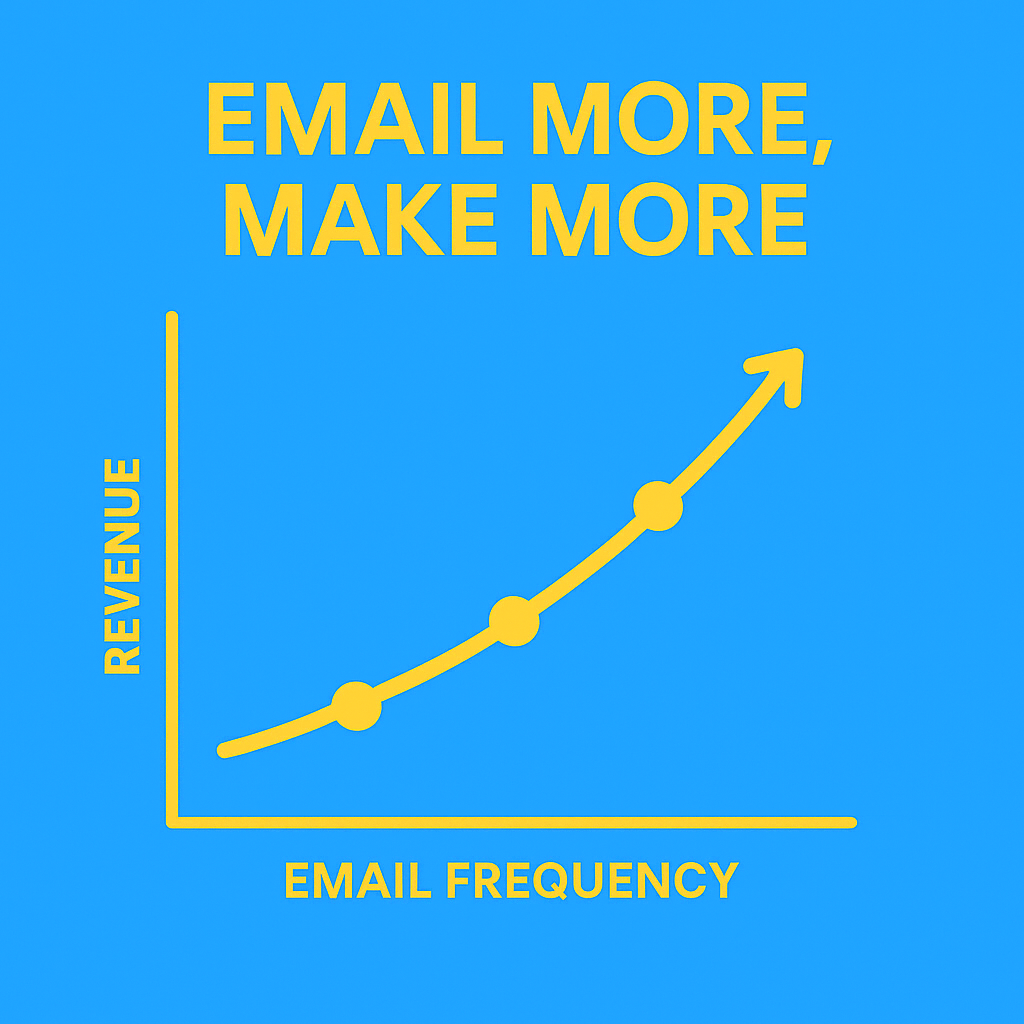
The System
We built a proper campaign calendar. Not random blasts when inspiration struck, but a structured rhythm that mixed different types of content:
- 3-4 campaigns per week (instead of 1–2).
- Content variety: product features, customer stories, seasonal offers, and educational tips.
- Testing frequency: watching unsubscribes and CTR closely to make sure we weren’t fatiguing the list.
By treating campaigns like the “heartbeat” of the business, email stopped being an afterthought and became a core revenue driver.
The Results
In the first year of shifting to this cadence, campaign revenue grew from $214,405 → $284,027, a 33% lift. And here’s the key: unsubscribes didn’t spike. In fact, engagement improved, because we were showing up more consistently with useful, relevant content.
Customers didn’t mind hearing from us more often, they expected it. That consistency built trust, and trust built revenue.
5-Minute Fix
Here’s how you can apply this today:
- Open your ESP.
- Schedule one extra campaign this week.
- Don’t overthink it. Keep it simple:
- Share three tips on how to get the most from your product.
- Highlight a customer review.
- Tell a short story about why your product exists.
That’s it. In under 5 minutes, you’ve doubled your chances of landing in the inbox on a day when your customer is actually ready to buy.
#2 Flows Are Gold
A flow is one or more emails that are sent automatically based on a customer or potential customers actions (like they signed up to something or browsed your website)
When I first reviewed the brand’s flows, they were… minimal. A single welcome email, maybe an abandoned cart reminder. Technically, they had flows set up, but they weren’t doing the heavy lifting.
And that’s the thing about flows, they’re not just “nice to have.” They’re the invisible engine of email marketing. Campaigns are important, but they’re like fireworks: you set them off, they flare up, and then they disappear. Flows are different. They’re the pipes in the wall, the systems that quietly move water where it needs to go without you even thinking about it.
I remember running the numbers in those early months. Nearly all the revenue was coming from campaigns. That meant every dollar depended on us sitting down, writing, designing, scheduling, and sending. If we didn’t send, we didn’t sell. It’s exhausting. Worse, it’s risky, if campaign performance dipped, the whole email channel dipped with it.
We needed flows to carry more of the load.
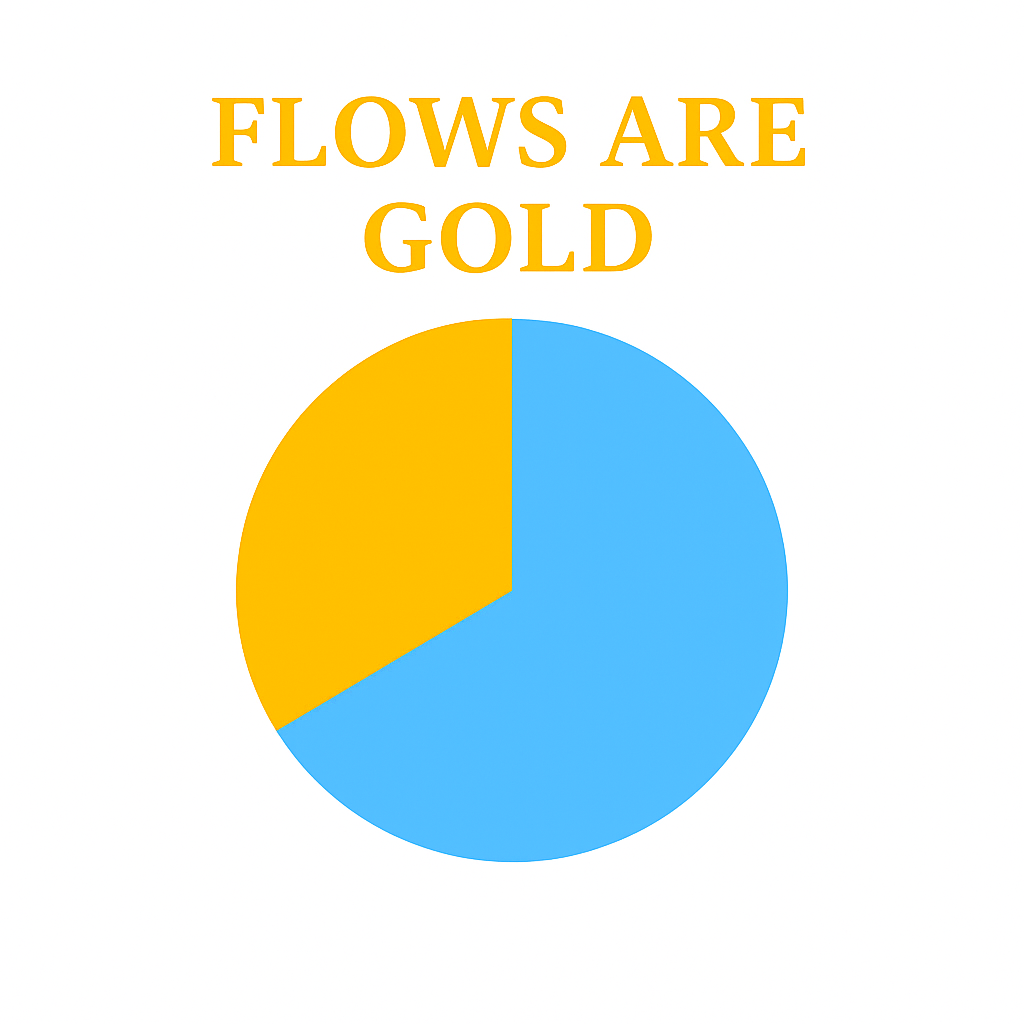
The System
We mapped out the entire customer journey and built flows to match behavior at every stage. Instead of just a welcome and a cart reminder, we created a flow ecosystem:
- Welcome Series (4–5 emails): Not just “Hi, here’s 10% off,” but a sequence that told the brand story, educated about the products, and made the first purchase feel like a natural step.
- Abandoned Cart (3 emails): First a gentle reminder, then urgency (“stock is limited”), then social proof (“customers like you bought this”).
- Browse Abandonment (2 emails): For people who window-shopped but didn’t add to cart: answers to FAQs, benefits, and a link back to what they viewed.
- Post-Purchase (3 emails): A thank you, education on how to get the best results, then a review request. Customers who felt looked after came back sooner.
- Reorder Reminders: Timed around the real usage cycle (e.g., vitamins running out in ~30 days). These weren’t guesswork, they were based on actual product consumption.
Each flow was short, simple, and behaviour-driven. No one was writing “extra” emails; the system worked automatically.
In fact, you can take some of your best performing campaigns, and just put them into your welcome series.
The Results
Flows transformed the revenue picture. Between Jan 2022 and Aug 2025, flows generated $647,580.56. In some months, flows actually beat campaigns.
That’s why flows aren’t optional. They’re the foundation. They ensure that when your campaigns underperform (and they will), you still have steady, compounding revenue.
5-Minute Fix
Here’s what you can do right now:
- Open your ESP.
- Check your abandoned cart flow.
- If you only have one reminder, add a second email.
- Keep it plain text and simple:
#3 Grow Your List the Right Way
When I audited list growth for this brand, there wasn’t a “giveaway problem.” Most new subscribers were either customers at checkout or people opting in for a discount code. There were a few free downloads, but they were generic, with no clear promise, no framing, and crucially not aligned to the buyer’s awareness level. That meant we were collecting addresses, but not learning who they were or what they needed next.
Two things were happening:
- Discount-first signups skewed price-sensitive. Great for a first purchase, not great for long-term value if we didn’t quickly reframe around outcomes.
- Untargeted downloads captured interest but gave us no signal about stage (pre-event, just-had-event, maintenance). Without that context, follow-ups were one-size-fits-all, and one-size emails rarely perform.
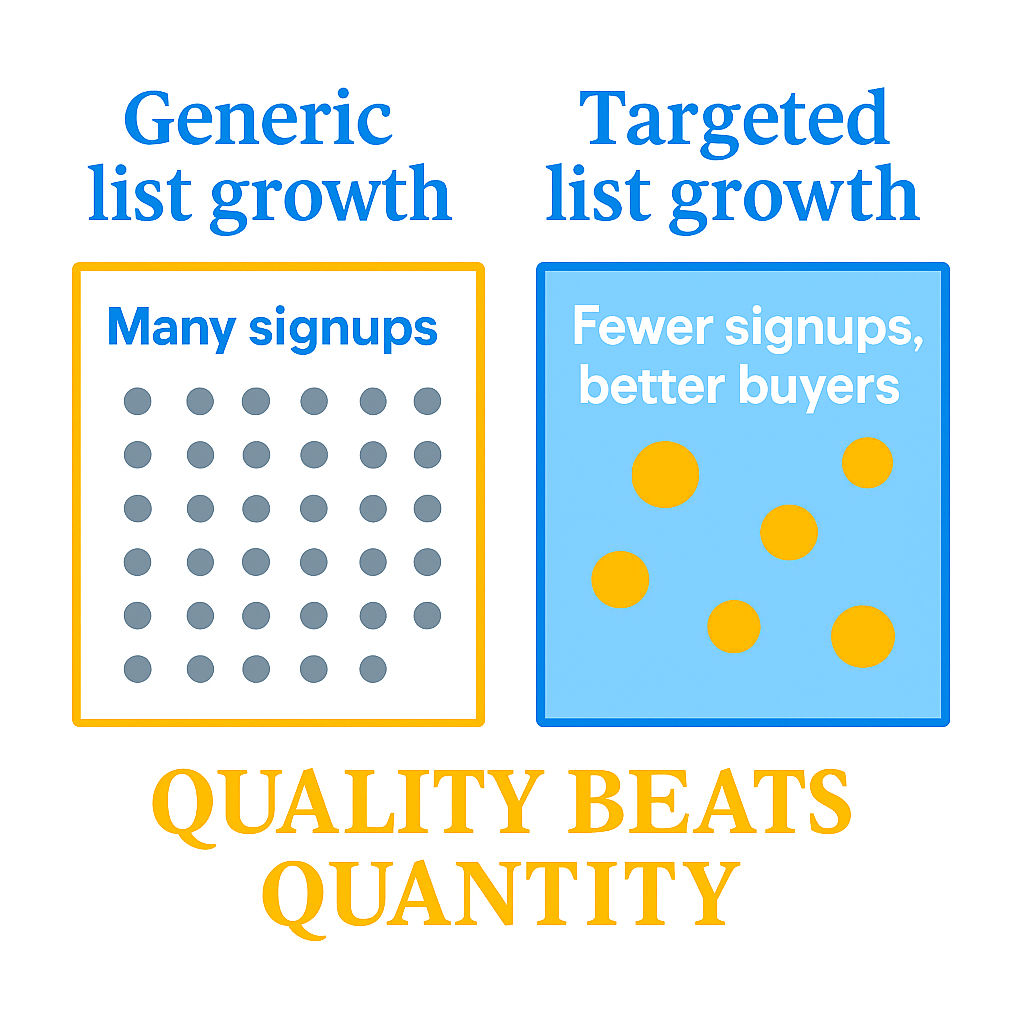
The System
We kept the checkout and discount-code streams (they work), but we layered in intent-based list growth and made every opt-in carry meaning:
Map stages of awareness to the real journey (Eugene Schwartz applied to your market):
- Pre-event → “What to expect,” “Questions to ask,” “Prep checklist”
- Immediate post-event → “First 30 days,” “Common mistakes,” “Recovery plan”
- Maintenance → “Weekly routines,” “Energy & nutrition planner,” “Troubleshooting guide”
Create specific lead magnets for each stage (1–3 pages is enough to start with):
- Checklists, mini planners, “avoid these X mistakes,” quick start plans, calculators.
- Make the title do the heavy lifting: clear promise, simple outcome, no fluff.
Tag by source + stage the moment they opt in:
- UTM on forms, hidden field for “stage,” or a one-click post-signup poll: “Where are you right now? Pre | Just had the event | Maintenance.”
Welcome paths, not a single welcome. Each magnet triggered a 2–4 email micro-welcome that matched the stage:
- Email 1: deliver the asset + set expectations
- Email 2: best practices + quick win
- Email 3: proof (story/testimonial specific to their stage)
- Email 4: soft CTA (the next step/product that actually fits their moment)
Sunset and recycle politely:
- If no opens in 120–180 days, move to a re-engagement path; if still cold, suppress.
- Keep deliverability clean and your averages honest.
The Results
Even with regular pruning, the list grew from 21,173 → 74,492 engaged subscribers.
The difference was night and day: instead of adding thousands of junk leads who never opened, we attracted steady streams of highly qualified subscribers who were much more likely to buy.
And when you combine that with more frequent campaigns and strong flows, the outcome isn’t just a bigger list, it’s a list that actually makes you money.
5-Minute Fix
Here’s something you can do right now:
- Spend 5 minutes brainstorming one resource your ideal customer actually wants.
- A “before” checklist (“7 Things to Do Before [X Event]”).
- A “mistakes” guide (“5 Common Mistakes to Avoid After [X]”).
- A quick-start tip sheet (“How to Get the Most Out of [Product/Service] in 7 Days”).
- Package it as a simple PDF or one-page guide.
- Put it behind a sign-up form on your site.
That one switch, from giveaways to value-based lead magnets, can completely change the quality of your list.
#4 Test Everything
In the beginning, most of our campaigns went out the way a lot of companies send them: someone wrote a subject line, added some copy, stuck in a button, and hit send. That’s not “wrong” ,but it means you’re working blind.
I remember comparing two back-to-back product campaigns. The offers were almost identical, the design was nearly the same, but the results were wildly different. One campaign brought in a solid chunk of sales. The other fell flat. And we had no way of knowing why. Was it the subject line? The layout? The timing? Without testing, you’re just guessing.
The breakthrough came when we treated every campaign like an experiment. Instead of hoping for the best, we built a simple process for finding out what actually worked.
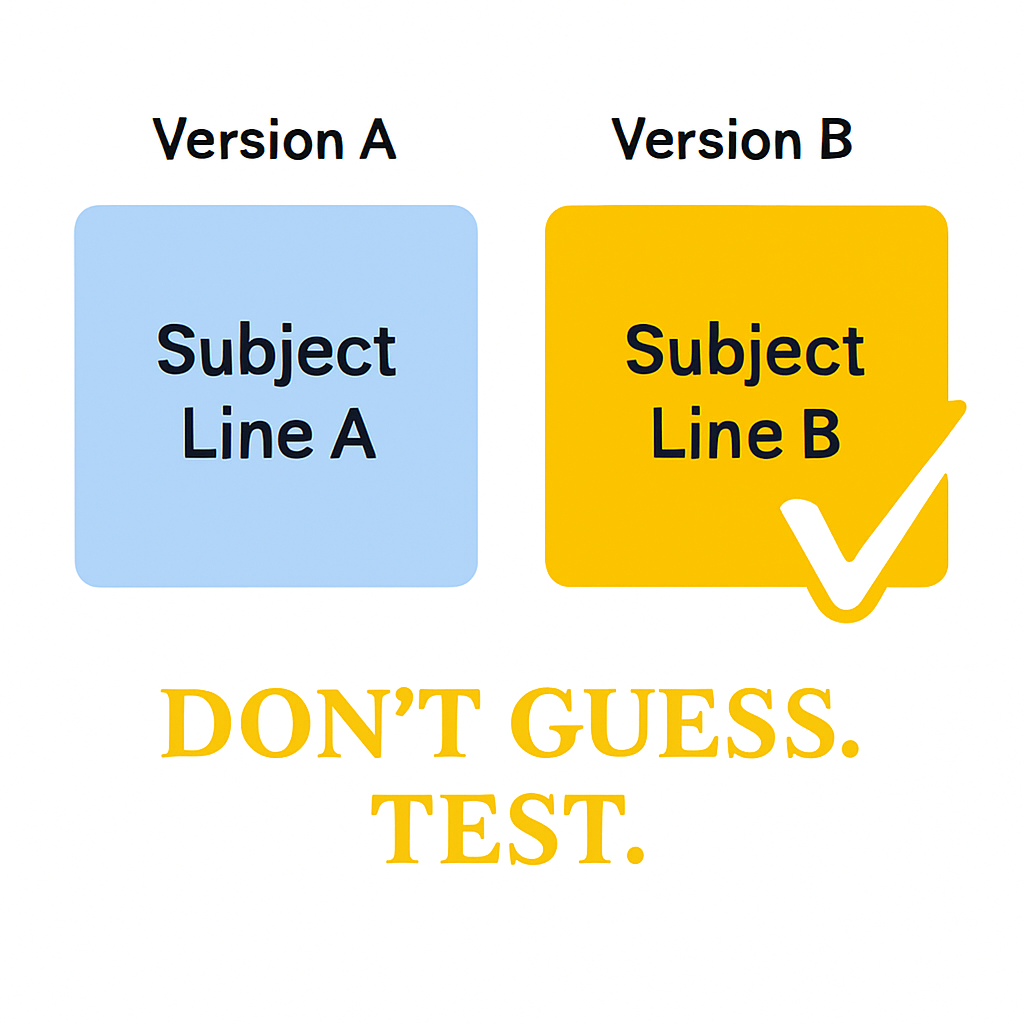
The System
Here’s how we made testing a habit (and not an afterthought):
One Test Per Campaign: Try to test one thing per campaign. A simple win to begin with is testing subject lines. As you get better, and your team grows you can move to testing more labour intensive ideas.
Keep It Simple: Don’t test five things at once. Test one variable:
- Subject line (question vs statement, short vs long)
- Preview text (curiosity vs benefit)
- Layout (plain text vs designed)
- CTA copy (“Buy Now” vs “Learn More”)
- Image type (lifestyle vs product)
Split the List: We’d send Version A to half the audience, Version B to the other half. Nothing fancy, just clean A/B testing.
Log the Results: We created a simple Google Sheet to track:
- Campaign name
- What we tested
- Which version won (and by how much)
- Notes on why we thought it worked
Over time, that spreadsheet became a playbook of what our audience actually responded to.
Roll Out Winners: When we found a clear winner (e.g., curiosity-driven subject lines consistently outperforming direct ones), we made it the default approach until something else proved better.
The Results
Testing shifted us from opinion-driven to data-driven. Instead of arguing over which subject line “sounded better,” we let the audience decide.
Across 643 campaigns, our average open rate hit 45.78% and CTR 0.52%. Some winning tests doubled click-through rates, and when clicks double, sales usually follow.
One of the most surprising wins? Plain text emails. Sometimes, simple, personal-looking campaigns beat carefully designed HTML templates. Without testing, we never would have known.
5-Minute Fix
Start small. Here’s what you can do today:
- Take the next campaign you’re about to send.
- Write two subject lines: one straightforward, one curiosity or benefit-driven.
- Set up an A/B split in your ESP.
- Send, log, repeat.
It takes 5 minutes, but if you do it consistently, you’ll know more about your audience in 6 months than most brands learn in 6 years.
You’ll notice something about the first four lessons: they’re all about getting the foundations right.
Sending more often, setting up flows, building your list properly, and testing everything. These aren’t flashy tactics. They are doing the basics.
Once you’ve nailed those, you’ll start to see consistent revenue, cleaner data, and a healthier list. That’s where most brands stop.
But if you want to go from “good” to “great,” the next step is to go deeper. The intermediate lessons are about refining how you think about email:
- How to write emails that sell the click, not the product.
- Why click rate is the real metric inbox providers care about.
- How to sequence your emails like mini sales letters.
- Why psychographics matter more than demographics.
- And how to segment smarter so you’re not blasting everyone the same message.
This is where email stops being a channel you “use” and starts becoming a system you master.
Intermediate Lessons (The Next Level)
Going from average, or even good, to great.
#5 Sell the Click, Not the Product
When I first started writing campaigns, I thought the inbox was where the entire sale had to happen. I’d write emails that tried to do it all: introduce the product, explain the features, share testimonials, handle objections.
But over time, the results showed something consistent: the best-performing campaigns weren’t the ones that explained everything. They were the ones that created just enough interest for the reader to say: “I want to know more.”
That’s the real job of an email. Not to close the sale, but to spark curiosity, relevance, or urgency so that the reader wants to click through. The landing page or product page can do the heavy lifting.
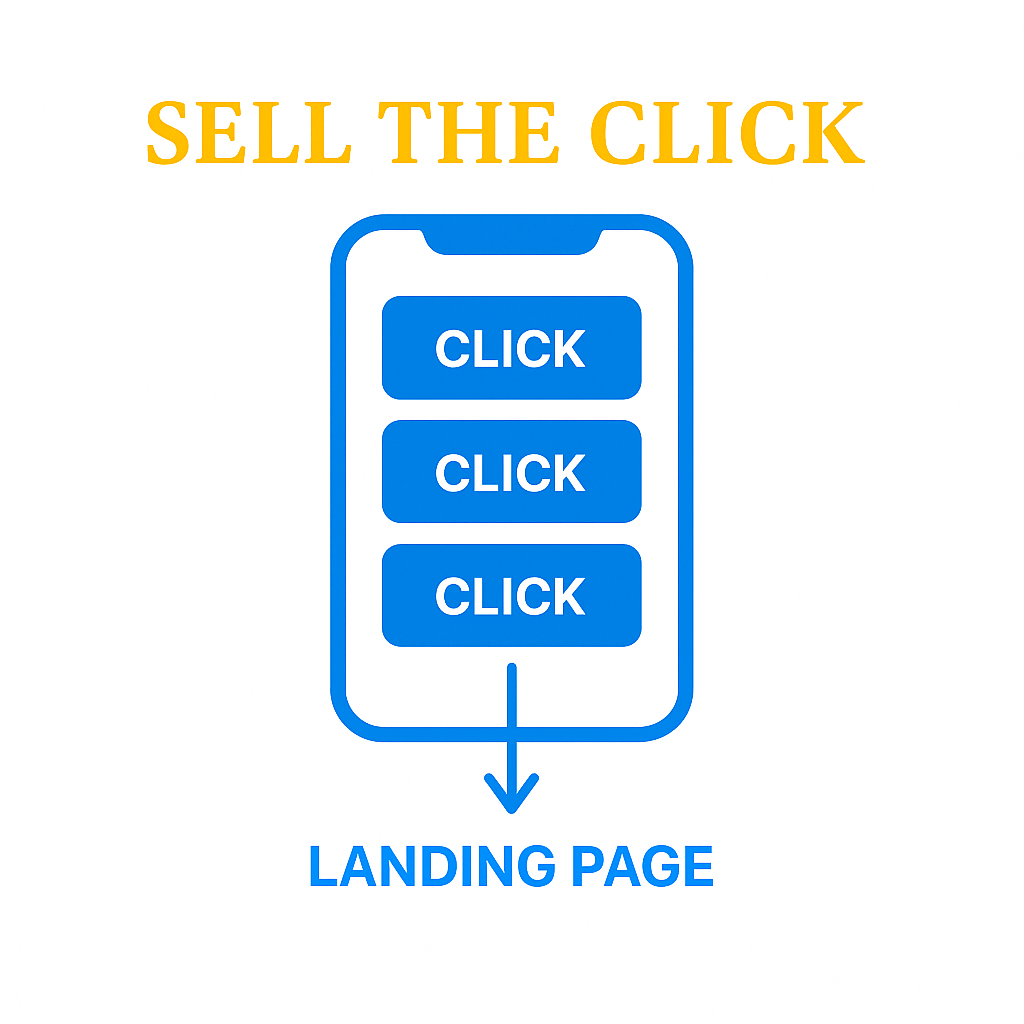
The System
We shifted our thinking and designed emails around a single goal: make the click irresistible. Here’s how:
Mobile-first design. Over 70% of subscribers read emails on their phone. That means the very first screen (“above the fold” on mobile) is prime real estate. We started including a clickable CTA right at the top — so if the reader was already interested, they didn’t have to scroll to act.
Strategic placement of CTAs. Instead of saving the button for the bottom, we layered CTAs throughout the email:
- One early (for high-intent readers).
- One in the middle, after building curiosity or handling an objection.
- One at the end, once the case was made.
This way, no matter where the reader was convinced, the “doorway” was right there.
Match length to awareness.
- For familiar customers (reorders, warm segments), short curiosity-driven emails with multiple buttons worked best.
- For new or colder segments, longer copy worked when structured as a story: hook → problem → proof → CTA. Each button in that flow came after we’d built enough belief to justify the click.
Clarity > cleverness. Buttons weren’t hidden or subtle. They were bold, clear, and unmistakable. No “read more here if you want.” Just: “See How It Works” or “Get Yours Now.”
The Results
This approach consistently improved CTR. Some emails doubled their click-through just by adding an above-the-fold button for mobile readers. Others lifted revenue because CTAs were placed at natural breakpoints where curiosity or urgency was strongest.
The biggest shift was psychological: we stopped asking the email to convince and started asking it to invite. Once we did that, our copy became cleaner, our CTAs sharper, and our results stronger.
5-Minute Fix
Open the draft of your next campaign and do three things:
- Add a CTA link or button above the fold (visible on mobile before scrolling).
- Place a second CTA halfway down the email, after your first big hook, proof point, or curiosity trigger.
- End with a bold, unmistakable CTA.
Now you’ve given readers three chances to say “yes” instead of one.
#6 Click Rate Is King
For a long time, the metric everyone obsessed over was open rate. I did it too. If a subject line pulled a 50% open rate, we’d celebrate. If it dipped into the 20s, we’d panic. But the more I dug into email performance, the more I realised something important: inbox providers like Gmail and Outlook don’t really care about opens.
What they care about is engagement, and the strongest signal of engagement isn’t opening an email. It’s clicking inside it.
Here’s why that matters:
- Opens are fuzzy. Apple’s Mail Privacy Protection inflated them. Image-blocking makes them unreliable. The number looks big but doesn’t always mean anything.
- Clicks are concrete. A click is someone raising their hand and saying, “Yes, I’m interested. Take me further.”
- Inbox placement depends on it. Gmail and other providers watch how many people interact with your emails. If too few are clicking, they’ll quietly reroute you into the Promotions tab, or worse, spam.
I remember watching this play out first hand. For months, our open rates looked strong ,often over 40%. But CTR was sliding. Soon after, deliverability started slipping too. More campaigns were landing in Promotions. Engagement tanked. That’s when I realised: click rate isn’t just a nice-to-have metric. It’s the canary in the coal mine.
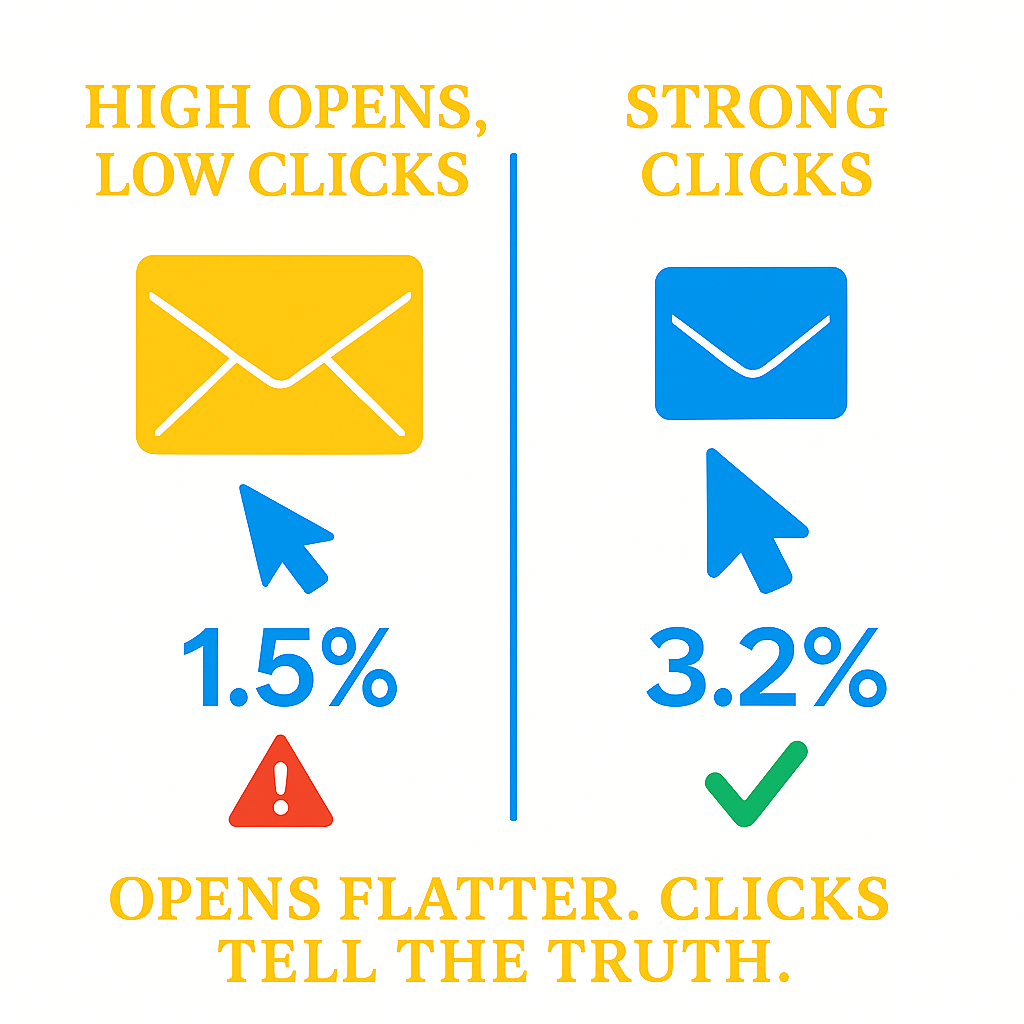
The System
Once we understood this, we made CTR our north star metric. Here’s what we did:
Shifted reporting focus.We stopped leading with “open rates” in campaign reports. The headline metric became CTR and placed order rate.
Optimised for curiosity and clarity.
- Subject lines were still important, but we measured them by how many clicks they drove, not just opens.
- The copy was trimmed to emphasise curiosity, benefits, and the “what’s next.”
CTA testing. We tested everything: button colours, placements, wording. “Learn More” sometimes outperformed “Shop Now.” Sometimes “See Why Customers Love This” crushed them both.
Design for the click. Every email was reviewed with one question: “If I were scanning this in 5 seconds, would I know where to click?” If the answer was no, we redesigned.
Segmented by engagement. High-engagement segments get sent to more often. Low-engagement segments were gradually suppressed or re-engaged with specific content. This protected CTR averages and kept inbox providers happy.
The Results
The change in focus had ripple effects:
- In 2025, average campaign CTR was 2.17%, with a placed order rate of 0.31%.
- When CTR dipped, deliverability followed. When CTR improved, inbox placement improved.
- By making CTR the core metric, we had an early-warning system: if clicks fell, it was time to investigate content, targeting, or deliverability before sales slipped further.
5-Minute Fix
Here’s something you can do right now:
- Pull your last 3 campaigns.
- Ignore open rates. Look only at CTR.
- Ask: what percentage of people who opened actually clicked?
That number is your baseline. Write it down. Now, for your next campaign, make one change; a sharper hook, a clearer CTA, or a better placement. See if you can beat it.
#7 Sequence Matters
One of the easiest mistakes to make with email is to treat it like a digital flyer. You throw in a few product shots, a discount code, and a big shiny button — then hope people click.
But email isn’t just about what you say. It’s about when and in what order you say it. The sequence of information inside an email determines whether a reader builds enough belief and curiosity to take the next step.
I saw this clearly when we tested different campaign structures. Emails that jumped straight from “Here’s a product” → “Buy it now” almost always underperformed. But when we built a flow inside the email itself, starting with an emotional hook, adding proof, layering in logic, and then ending with a clear CTA, results were consistently better.
This isn’t just intuition. It’s persuasion psychology. People rarely buy because of one isolated fact. They move through stages: first an emotional reason to care, then proof that backs it up, then logic that justifies it, and only then are they ready for the call-to-action.
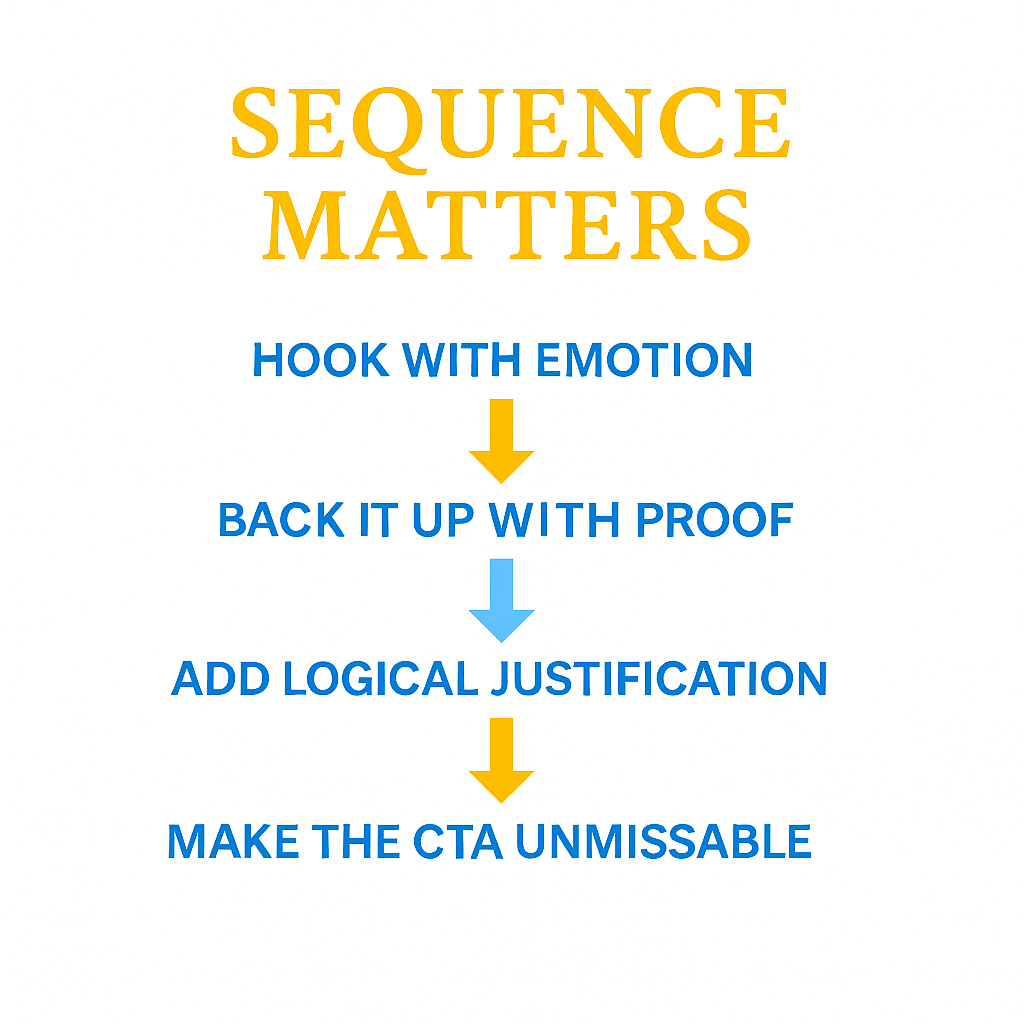
The System
Here’s the sequence we used inside emails (and across campaigns):
Hook with Emotion
- A bold statement, question, or story that connects with what the reader cares about most.
- Example: “Tired of running out of energy halfway through your day?”
Back It Up with Proof
- Social proof, testimonial, or data point that shows this isn’t just hype.
- Example: “Over 20,000 customers use this to keep their energy steady all day.”
Add Logical Justification
- Simple explanation of why it works (science, ingredients, process).
- Example: “Because it delivers complete protein plus vitamins in a single serving, your body absorbs what it needs quickly.”
Make the CTA Unmissable
- Strong button with one job: click.
- Example: “See How It Works” or “Get Yours Today.”
And here’s the nuance: just like in Lesson 5, this isn’t about length. A two-line email can still follow this flow (hook → proof → CTA). A longer storytelling email just stretches it out. The sequence matters more than the word count.
The Results
When we applied this structure, CTR improved consistently. For example:
- A campaign that originally just listed product features was rewritten to follow the sequence. CTR lifted by over 40%.
- In longer launches, placing testimonials before the CTA (instead of after) often made the difference between a mediocre send and a strong one.
The key insight: people need to be guided. If you skip steps, you lose them. If you dump logic before emotion, they glaze over. If you ask for a click before you’ve given proof, they hesitate.
5-Minute Fix
Pull up one of your recent campaigns and ask:
- Did I start with emotion?
- Did I back it up with proof?
- Did I explain the logic?
- Did I finish with a clear CTA?
If not, rewrite it quickly using this sequence. Even just re-ordering the content you already have can dramatically improve performance.
#8 Know Your Customer for Real
When I first started out, I leaned heavily on demographics. We knew the typical customer was a woman between 35 and 50, living in the Midwest, usually married, often with kids. That was useful… but not enough.
The problem with demographics is they tell you who your customer is, but not why they buy. Age and location don’t explain the sleepless nights, the frustrations, or the desires that actually drive decisions.
This came into focus when we built a customer avatar we called Linda. She’s not just “a woman in her 40s.” Linda is busy. She’s tried diets before and been derailed. She prepares meals for her family and ends up snacking on scraps instead of eating properly. Late at night, she’s hungry, she binges, and she feels guilty. Her biggest fear? Not having enough energy to keep up with her kids, or worse, dying young.
That’s what kept her awake at night. And once we understood that, our emails got sharper, more empathetic, and more effective.
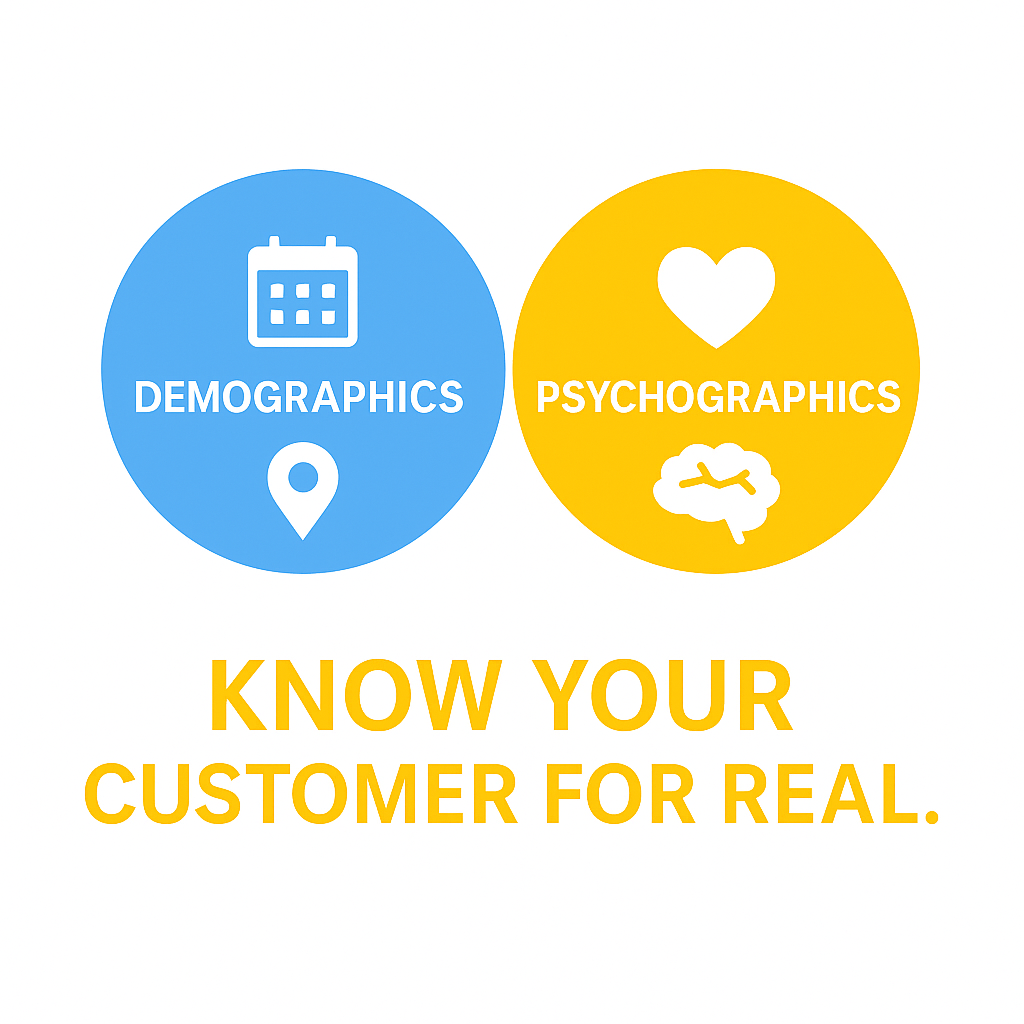
The System
We reframed our research around psychographics, not demographics. Here’s how:
Listen where they hang out. Forums, Facebook groups, YouTube comments, Amazon reviews. What problems do they talk about? What language do they use?
Map desires and roadblocks. For Linda, it wasn’t just “lose weight.” It was:
- Desire: “I want energy to keep up with my kids.”
- Roadblock: “I’m too tired to exercise.”
- False belief: “If I skip meals, I’ll lose faster.”
Channel Eugene Schwartz. Ask: what stage of awareness is she in? Is she problem-aware, solution-aware, or product-aware? Tailor messaging accordingly.
Build empathy into copy. Instead of leading with “X grams of protein,” lead with: “Tired of running out of energy before the day is done?” That speaks to her lived reality.
The Results
The difference was obvious in engagement. Emails written with Linda in mind pulled stronger CTRs and higher conversions because they felt personal. Customers wrote back saying things like, “This is exactly what I’m going through.” That’s how you know you’ve struck the right chord.
By treating Linda like a real person with fears, frustrations, and dreams, not just a data point, the copy shifted from generic to empathetic. And empathetic copy gets read, clicked, and acted on.
5-Minute Fix
Take 5 minutes to answer these three questions about your customer:
- What do they really want (beyond the product)?
- What’s the roadblock stopping them from getting it?
- What false belief keeps them stuck?
Write those answers in their own words. Use them in your next subject line or opening sentence. You’ll instantly sound more relevant — and more human.
#9 Segmentation Is Everything
In the early days, we often sent campaigns to the whole list. On paper, that looked efficient: one email, one send, maximum reach. But the results told a very different story.
From Sep ’22 – Sep ’23, when engagement was tighter and the list was cleaner, CTR averaged 1.05%. As the list grew and we leaned into full-list sending, CTR fell to 0.56% the following year. By Oct ’24 – Aug ’25, it was hovering at just 0.54%.
That drop matters. CTR isn’t just about clicks, it’s the signal inbox providers use to decide whether your emails deserve prime placement or should be quietly filtered into Promotions or spam. Lower CTR meant weaker inboxing, fewer engaged subscribers, and more work to claw our way back.
The lesson was clear: blasting everyone hurts. Targeting the right segments helps.
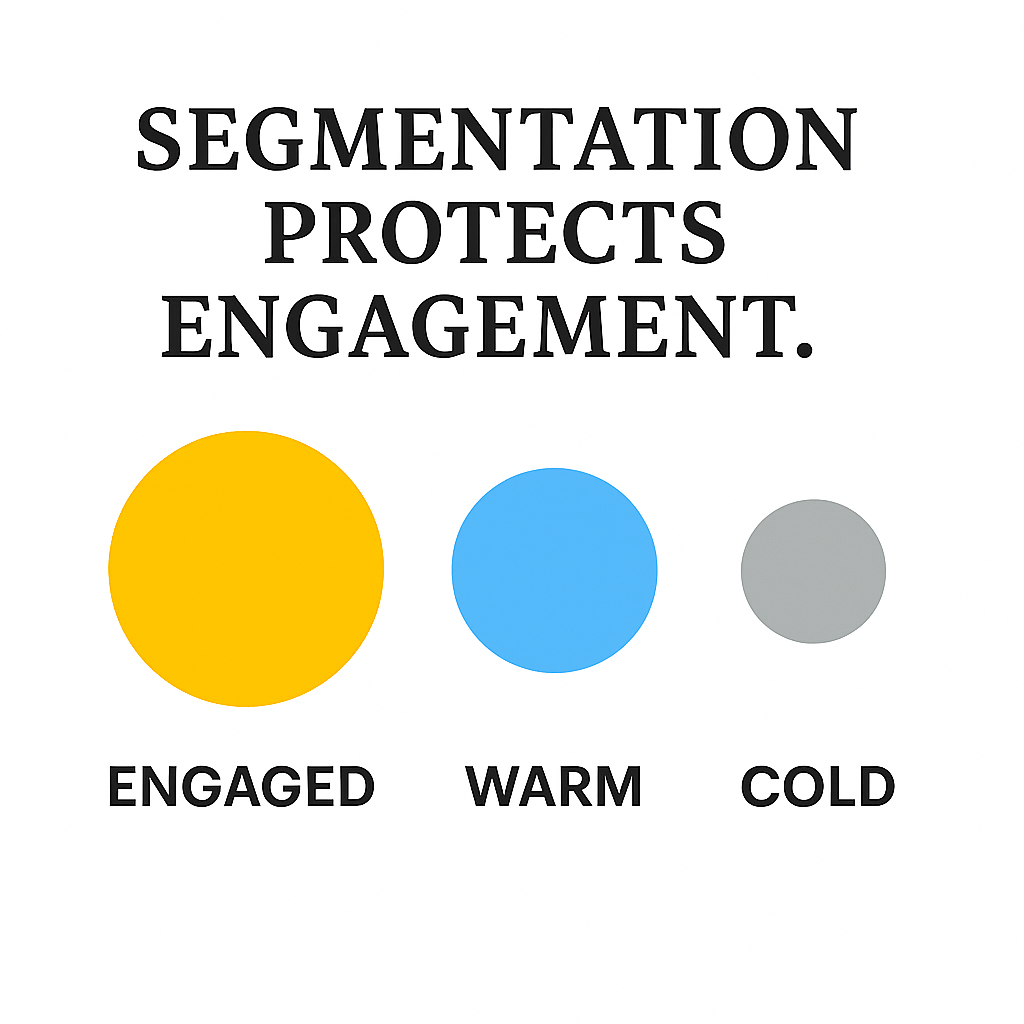
The System
We adopted a segmentation-first approach, using the RFM model:
- Recency: Who has opened or clicked in the last 30 days?
- Frequency: Who engages consistently vs occasionally?
- Monetary value: Who has spent the most?
From there, we created tiers:
- Engaged Core (recent openers, frequent buyers): Emailed most often.
- Warm Middle (occasional openers, some purchases): Emailed regularly but less aggressively.
- Cold Tail (no engagement in 90+ days): Shifted to win-back or suppression.
This didn’t just protect CTR — it made our campaigns more profitable. Instead of sending 100,000 emails to get 500 clicks, we sent 50,000 to get the same 500 clicks, plus happier inbox placement and fewer unsubscribes.
Need help with your email strategy? Let's jump on a call.
The Results
When CTR halved (1.05% → 0.54%), we could trace it directly to over-mailing the whole list. Once we began leaning harder into segmentation, CTR stabilised and deliverability improved.
Segmentation became not just a best practice but a lifeline for engagement.
5-Minute Fix
Log into your ESP and create a segment for “Engaged 30 Days” — subscribers who opened or clicked in the last month.
Send your next campaign to them first. Then compare CTR against your full-list sends.
Chances are, you’ll see fewer sends, better engagement, and stronger deliverability.
#10 Benchmark Against the Best
One of the most dangerous mistakes in email marketing is thinking you only need to study your own campaigns. Early on, I fell into that trap, obsessing over our open rates, CTR, revenue per send, but not looking outward.
The problem? Your customers don’t just see your emails. They see everyone’s emails. Health brands, lifestyle brands, retailers, influencers, their inbox is a competitive arena. If your design, storytelling, or offers feel flat compared to what they’re used to elsewhere, you’ll get ignored, no matter how good your product is.
This hit me when I started actively analysing the inboxes of other health and supplement brands, not just direct competitors, but adjacent niches like women’s wellness, menopause support, or even home products. It became clear: customers are benchmarking you against the best emails they receive, not just against your last send.

The System
Here’s how I started building benchmarking into the workflow:
Inbox Swipe File.I created a dedicated email account and subscribed to 50+ brands across supplements, wellness, e-commerce, and lifestyle. Every week, I’d review what they were sending, when they were sending, and how they structured offers.
Pattern Spotting.
- Who was running plain text campaigns vs designed ones?
- Which brands used storytelling vs discounts?
- Where were buttons placed? How often?
- How were they segmenting (e.g., seasonal promos, replenishment nudges)?
Cross-Industry Inspiration. I didn’t limit myself to supplements. Sometimes the best ideas came from unexpected places: a homeware brand with brilliant re-engagement emails, or a DTC skincare company with seamless upsell flows.
Translate, Don’t Copy. The key was never to lift ideas wholesale, but to adapt the principle behind them. If another brand was training their audience to click by sending weekly “tip of the week” emails, we’d ask: what’s our version of that for our audience?
The Results
Benchmarking gave us an external standard to measure against. Instead of asking, “Is this email better than our last one?” we asked, “Would this email stand out in a crowded inbox alongside the best brands in the world?”
That shift raised the bar. It pushed us to sharpen our copy, test more aggressively, and design with clarity instead of clutter. Some of our most successful campaigns, including educational series that outperformed discounts were inspired by benchmarking outside our niche.
5-Minute Fix
Set up a swipe file inbox today:
- Create a new Gmail account.
- Subscribe to 20–30 top brands in your industry and outside it.
- Once a week, spend 5 minutes scanning for:
- Subject lines that grabbed you
- Design patterns (placement of CTAs, use of images, length of copy)
- Offer structures (discounts, bundles, gifts)
Pull one idea you can adapt for your next campaign.
Up to this point, we’ve covered the foundations and the refinements, the lessons that build consistency and momentum:
- sending more often
- setting up flows
- growing your list the right way
- testing everything
- writing for the click
- focusing on CTR
- sequencing properly
- knowing your customer deeply
- and segmenting with care
Those lessons took time to learn, but once we got them in place, they gave us steady results.
The next set of lessons? These are harder. They’re not neat tactics you can apply once and tick off the list. They’re the uncomfortable truths, the things I’m still working on with this client today.
These advanced lessons force you to step back, zoom out, and think about email not just as a channel, but as part of a bigger ecosystem. They’ve been the toughest to learn, and the ones I’m still wrestling with.
Advanced Lessons (The Hard Truths)
The uncomfortable realities and bigger problems that you probably won’t fix overnight.
#11 Attribution Is Fragile
Marketers love big numbers. It’s tempting to stretch attribution windows so your channel looks like it’s driving more revenue. For example, if you send an email today and a customer buys five days later, many ESPs will count that as an “email-driven” sale.
The problem? That’s not how customers behave, and it’s not honest reporting.
I saw this clearly when we partnered with an agency that shortened our attribution window from three days to just one. On paper, revenue suddenly dropped. But when we thought about it logically, it made sense: if a subscriber is going to act on an email, they’ll usually do it within 24 hours. Anything later is probably influenced by another channel; an ad, organic search, a word-of-mouth nudge.
That’s when it hit me: attribution is fragile. It looks precise, but in reality, it’s a blend of guesswork, tracking rules, and assumptions.
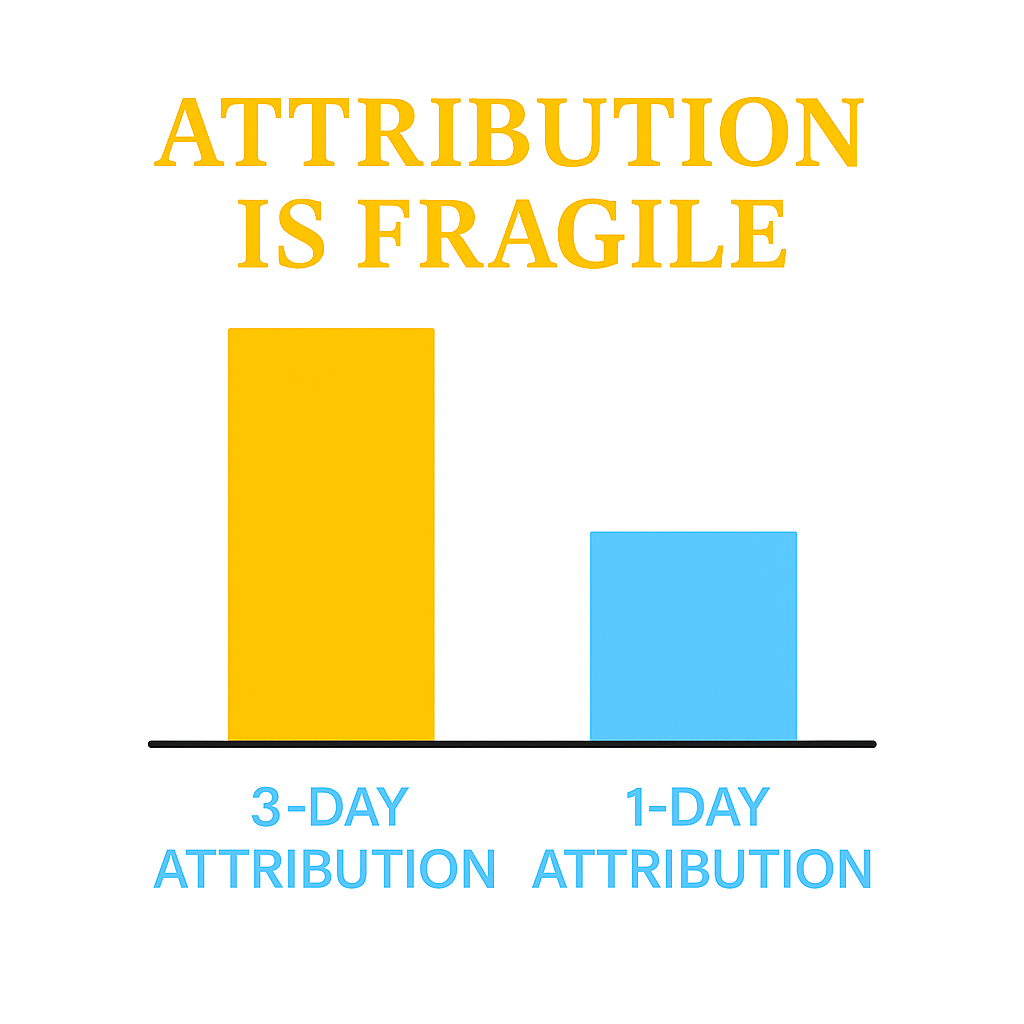
The System
Here’s how we started treating attribution with the respect it deserves:
Shortened the window. We adopted a strict 24-hour attribution rule. If the order didn’t come in within a day of the send, the email didn’t take credit.
Contextualised the data. We didn’t look at email revenue in isolation. We cross-referenced with ad spend, organic search spikes, and promotions. Attribution had to fit the bigger picture.
Look at relative trends, not absolutes. Instead of obsessing over whether an email drove $5,000 or $7,000, we asked:
- Did this campaign perform better than our last three?
- Did this flow outperform others with similar triggers?
Communicated clearly. When reporting to stakeholders, we made it explicit:
“This revenue is email-attributed within 24 hours. Anything outside that is influenced by multiple channels.”
The Results
Yes, our “reported” revenue number shrank. But the credibility went up. We could show stakeholders that when we claimed $1.35M in email revenue, it was real, not inflated.
This also changed how we thought about optimisation. With a tighter attribution lens, we saw which flows and campaigns truly pulled their weight, and which ones were coasting on generous attribution windows.
5-Minute Fix
Review your attribution settings right now:
- If your ESP is set to 3-day or 5-day attribution, shorten it to 1 day.
- Then pull your last month of campaigns and compare: how much “revenue” disappears when you only count 24 hours?
That gap is eye-opening. And it will force you to focus on campaigns that actually drive action — not inflated reports.
#12 Deliverability Can Kill You
Most marketers don’t think about deliverability until it’s too late. The assumption is simple: “If I send an email, it’ll land in the inbox.” But that’s not always true, and when it isn’t, it can quietly destroy your results.
I learned this the hard way. For months, our campaigns looked fine on the surface. The list was growing, the cadence was consistent, and open rates seemed decent. But CTR started slipping, and revenue didn’t match the volume of sends.
That’s when we ran tests across different inboxes; Gmail, Outlook, Yahoo. The result was sobering: too many of our campaigns weren’t landing in the primary inbox. They were being filtered into Promotions, or worse, slipping towards Spam.
It wasn’t a content problem or a copy problem. It was a deliverability problem.
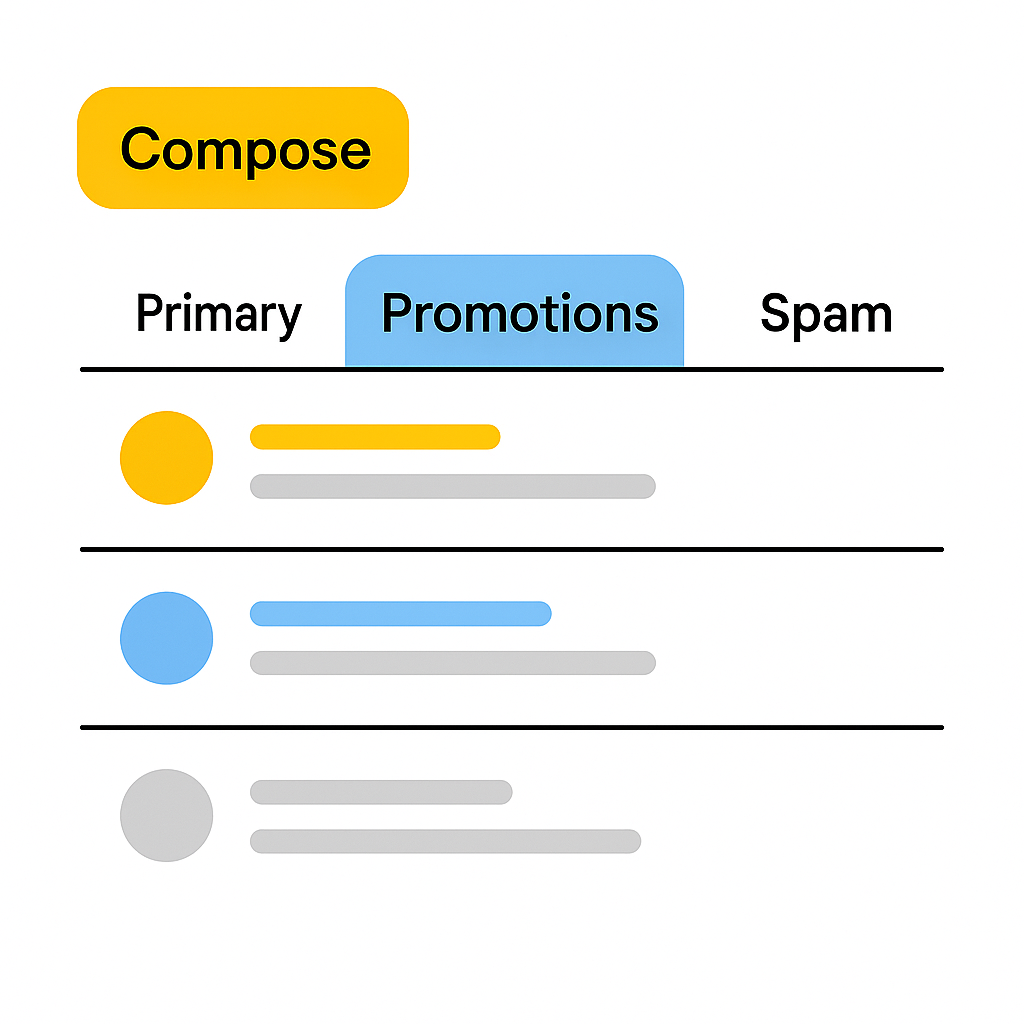
The System
Here’s what we learned (and fixed):
Promotions Tab Reality. When you're emailing frequently to Gmail accounts, landing in Promotions is almost unavoidable. But with careful thought this can be avoided, and even reversed. Though this takes time.
Engagement Signals Matter. Inbox providers watch:
- How many people open
- How many click
- How many delete without reading
- How many mark you as spam
Strong CTR and low complaint rates keep you safe. Weak CTR pushes you further down.
List Hygiene. Sunsetting became non-negotiable. We aggressively removed unengaged subscribers after 120-180 days. A smaller, healthier list delivered better inbox placement than a bloated one with dead weight.
Testing Every Send. We began running every campaign through tools like GlockApps or by manually testing across different inboxes. If deliverability was slipping, we’d know before it cost us thousands.
Content Adjustments.
- Fewer images, more balanced text-to-image ratio
- Avoided spammy words (FREE!!!, GUARANTEED)
- Simplified HTML to make emails “lighter”
The Results
Once we focused on deliverability, CTR stabilised, and sales recovered. The difference wasn’t in what we said but in whether our customers ever got the chance to see it.
The big realisation: you can have the best copy, the best design, and the best offer, but if your deliverability tanks, none of it matters.
5-Minute Fix
- Pull your last 3 campaigns.
- Check which folders they landed in (Primary, Promotions, Spam).
- If too many are hitting Promotions or Spam, start by:
- Removing unengaged subs (sunset policy at 120–180 days).
- Adding a second CTA or improving clickability to lift CTR.
- Testing your content for spam triggers before sending.
#13 CRO Matters as Much as Copy
There were campaigns where I felt confident: the subject line was sharp, the open rate was solid, and the click-through rate was healthy. By all the classic email metrics, the campaign was a win.
But when we pulled the revenue report, the sales just weren’t there. That’s when the penny dropped: the problem wasn’t the email. It was what happened after the click.
If you’re driving people to a weak landing page or a generic product detail page, even the best email in the world can’t save you. You can write the most compelling copy, nail the sequence, and generate curiosity, but if the landing page fails to convert, you’re leaking revenue with every send.
This has been one of the toughest ongoing lessons with this client: conversion rate optimisation (CRO) matters just as much as copy.
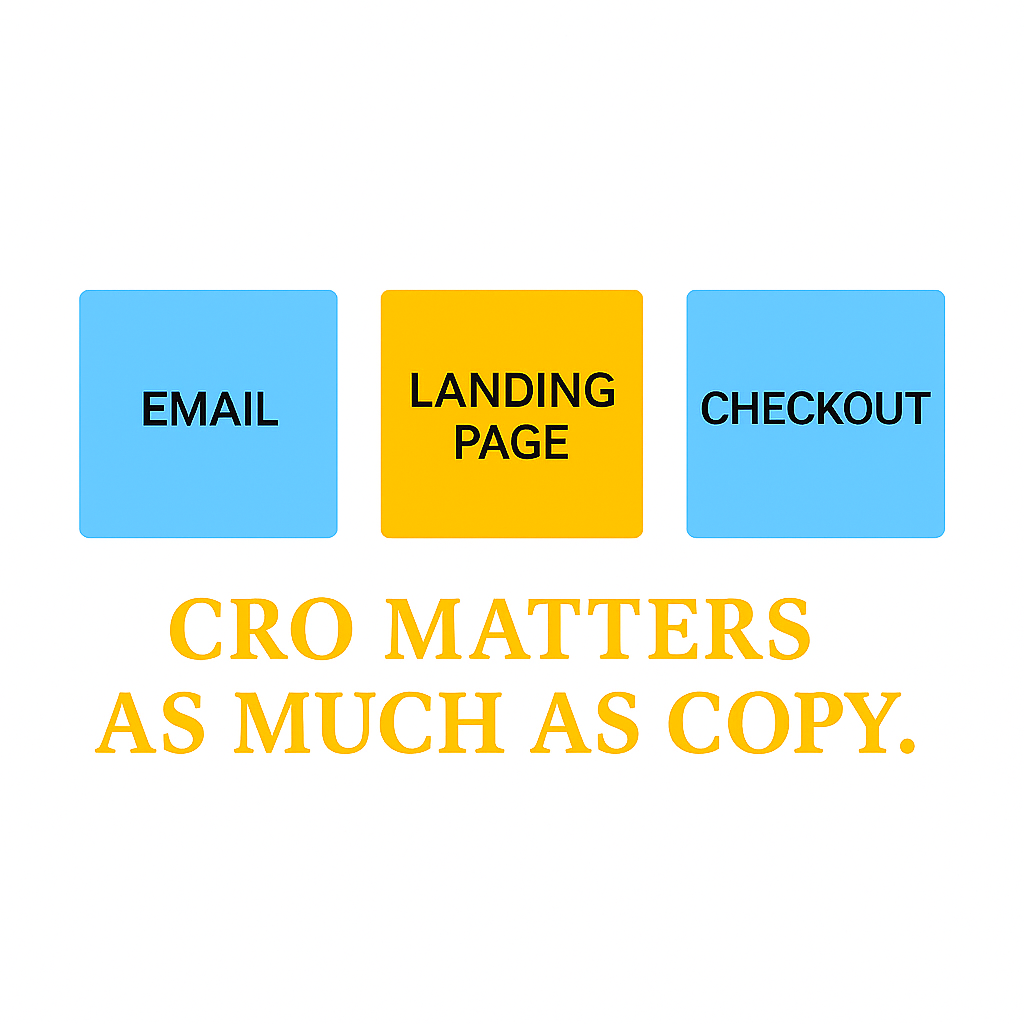
The System
Here’s how we started approaching it:
Audit the journey after the click. We mapped the path: email → landing/product page → checkout. Where were people dropping off? Was it confusion? Lack of proof? Too many steps?
Advertorial-style pages. Instead of dumping traffic on a bare product page with a picture, price, and “Add to Cart,” we built advertorial-style pages. These combined story, proof, education, and a CTA. For example:
- Customer stories + testimonials to create trust.
- Simple graphics or comparisons showing why this product vs competitors.
- “Before/after” framing tied to customer desires (e.g., more energy, less fatigue).
Add friction where it matters, remove it where it doesn’t. We reduced checkout friction (fewer clicks, clearer options), but added credibility “friction” on the page; FAQs, science references, testimonials. The kind of information that builds belief.
Iterate like we do with emails. Just as we A/B tested subject lines, we began split-testing landing pages: headlines, testimonials, product images, CTA buttons.
Looking for a trusted partner to level up your email strategy. Let's chat.
The Results
When the email was strong but sales lagged, improving the landing page almost always lifted conversions. In some cases, we saw a 20–30% improvement in placed order rate just by switching from a bare product page to an advertorial-style page with story + proof.
The key lesson? Email metrics (opens, clicks) are only half the story. If clicks aren’t turning into sales, the bottleneck isn’t in your subject line or CTA. It’s on the page they land on.
5-Minute Fix
Pick your best-performing product email. Click through as if you were a customer.
Ask yourself:
- Does this page answer the obvious questions?
- Does it show me proof that people like me have succeeded with this product?
- Does it make the next step (buy, subscribe, add to cart) dead simple?
If the answer to any of those is “no,” make one quick change:
- Add a testimonial above the CTA.
- Add a simple FAQ block.
- Add one comparison chart (your product vs alternatives).
Even one small tweak can lift conversions immediately.
#14 Promotions ≠ Discounts
When most companies think about running a promotion, the first idea is simple: give a discount. It’s easy, measurable, and you can always fall back on “10% off” or “Buy One Get One.”
But here’s the problem: if your only lever is discounting, you’re training your customers to wait for sales. They’ll stop buying at full price and start asking themselves, “When’s the next 20% off?” I’ve seen this happen in real time: revenue goes up during promotions, but flatlines in between.
That’s when I realised: promotions are bigger than discounts. A promotion is anything that creates urgency, excitement, or additional value for the customer.
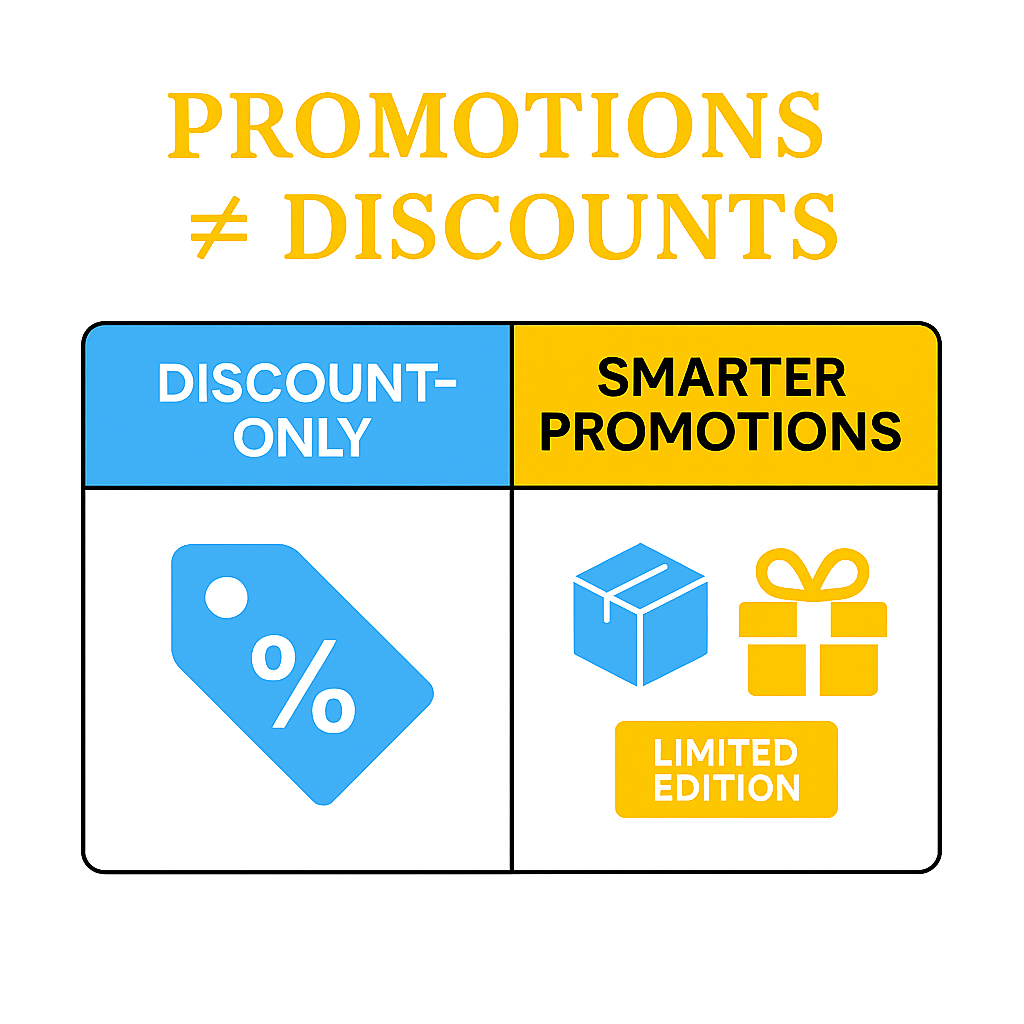
The System
Here’s how we reframed promotions with this client:
Bundles Instead of Discounts.
- Example: “Buy 2, Save More” or “Family Pack.”
- Bundling increased AOV without killing margins.
Free Gift with Purchase.
- Tote bags, shakers, or sample packs cost little to produce but feel high-value.
- They also act as long-term brand touchpoints (a tote bag is walking advertising).
Limited-Time Offers That Aren’t Just % Off.
- Early access to a new flavour.
- A seasonal edition available for one week only.
- “Spend $50, get a bonus sample.”
Anchoring Promotions to Milestones.
Tie them to events that already matter: customer anniversaries, “National Nutrition Month,” or even quirky dates (“Protein Day”).
Discounts as a Last Resort
We still used discounts, but strategically, not constantly. And always measured against unit economics.
The Results
The biggest change wasn’t just revenue. It was customer behaviour.
Instead of waiting for discounts, customers started responding to other triggers: excitement about new launches, fear of missing out on limited editions, or the perceived value of a free add-on.
Discounts became one tool among many, not the only lever we had to pull. And when we did use them, they carried more weight.
5-Minute Fix
Pull up your last three promotions. Were they all discounts?
If so, brainstorm one non-discount idea you could test:
- A simple bundle (“Buy 2, Save 10%”)
- A free gift with purchase (something low-cost but high-visibility)
- A limited-time variant or early access launch
Set it up as your next promotion and see how your customers respond.
#15 Coupons Still Work
Coupons might feel old-fashioned. Some marketers worry they “cheapen” the brand, others prefer auto-applied discounts at checkout for a smoother experience.
But here’s the truth: coupons still work, and not just for sales, but for tracking.
This isn’t new. In fact, coupons have been at the heart of direct response since the early 1900s, when ads in newspapers and magazines told customers: “Cut out this coupon and mail it in.” Why? Because coupons gave advertisers something priceless: a way to track where their sales came from.
And the same principle applies today in email marketing. Coupon codes are one of the simplest, most reliable ways to measure what’s working, not just inside your ESP, but across channels.
When we tested auto-applied discounts vs coupon codes, auto-apply felt smoother, but coupons drove more engagement and better attribution. Customers clicked more, redeemed more often, and we knew exactly which campaign drove the order.
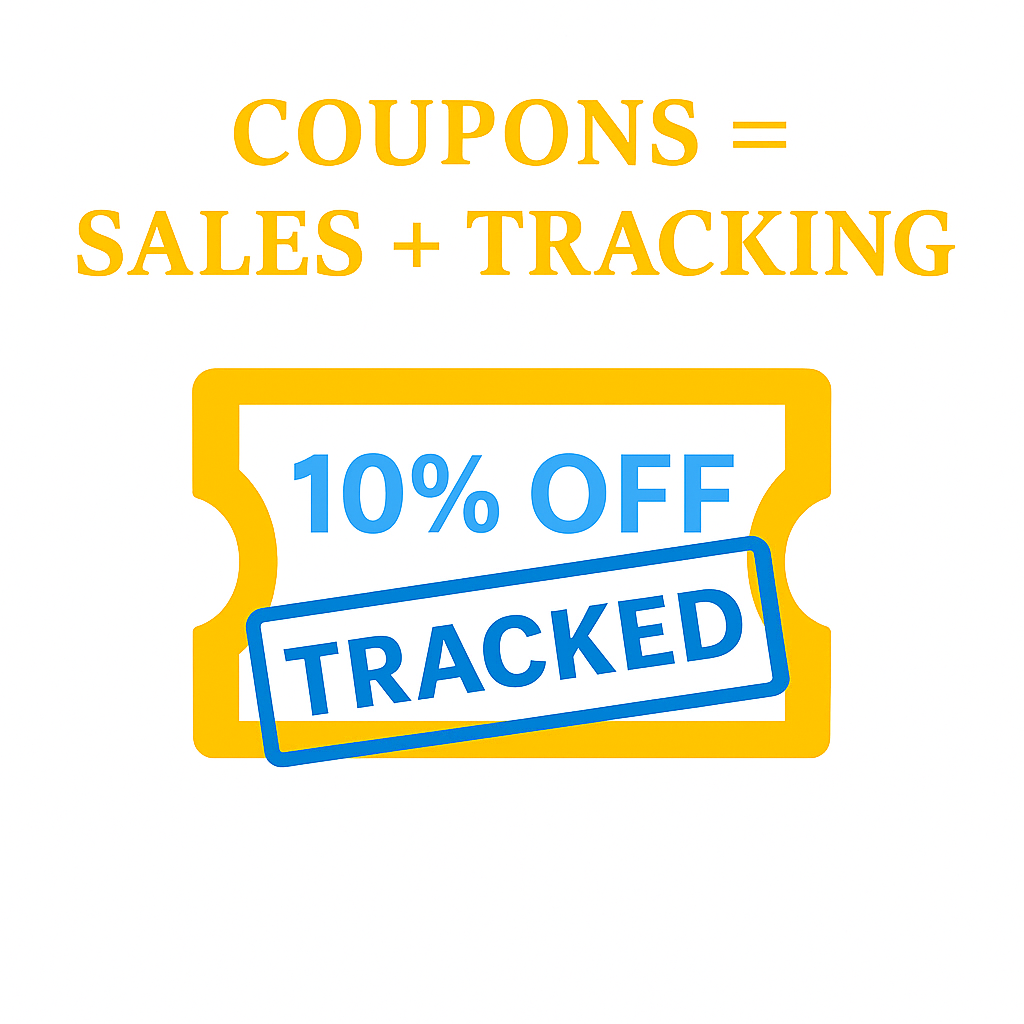
The System
Here’s how we made coupons work as both a sales lever and a tracking tool:
Unique Codes per Campaign. Every major campaign has its own code. That way, when the orders came in, we knew precisely which email had driven the sale, no inflated attribution, no guessing.
Expiry Dates for Urgency. Coupons always had a 24–72 hour expiry. Without urgency, they get forgotten. With urgency, they drive fast clicks.
Segment-Specific Codes. Coupons were tailored to behaviour:
- Win-back offers (“We miss you — here’s 10% off if you order this week”)
- Abandoned cart nudges (“Still thinking? Use this code before it expires”)
- VIP exclusives (“As one of our best customers, here’s an exclusive thank-you code”)
Beyond Discounts. Coupons weren’t just about % off. Sometimes the code unlocked free shipping, a free sample, or a gift with purchase.
The Results
Coupons consistently boosted CTR and placed order rates — but more importantly, they gave us cleaner attribution.
For example, if Campaign A offered ENERGY10 and Campaign B offered STAYSTRONG, we could instantly see which offer pulled better, and whether customers cared more about price, convenience, or bonuses.
This level of tracking wasn’t just helpful for email, it influenced ad copy, landing pages, and future promotions.
5-Minute Fix
For your next campaign:
- Create a unique coupon code tied to that email (e.g., ENERGY10).
- Make it expire within 48 hours.
- Track the redemptions separately in your ecommerce platform.
Now you’ll not only see sales, but you’ll know which campaign and which offer pulled them in.
16. Be Intentional About Frequency
When I first took over campaigns, one of the brand’s biggest worries was: “If we email too much, people will unsubscribe.”
That fear is common, and it usually leads to under-emailing. At the start, they were sending maybe once or twice a week. It felt “safe,” but the revenue was flat.
Over time, we pushed harder. Three times a week. Four times a week. And guess what? Unsubscribes didn’t spike. In fact, overall engagement went up, because we were showing up more often and with more varied content.
But then came the second-order consequence: deliverability issues. By mid-2024, we were pushing frequency harder without keeping enough eye on CTR. That landed us in Gmail’s Promotions tab more often, and once CTR started sliding, so did inbox placement.
That’s when the real lesson became clear: frequency itself isn’t the problem. Unintentional frequency is.

The System
Here’s how we began treating frequency with discipline.
Segment by Engagement.
- Engaged 30 Days → emailed more often (3–4x per week).
- Warm (90 Days) → emailed moderately (1–2x per week).
- Cold (90+ Days) → moved to win-back or suppressed. This meant we weren’t over-emailing the least interested people, but we stayed highly visible to those who wanted to hear from us.
Mix Campaign + Flow Balance. We tracked how many touchpoints a subscriber was realistically getting per week. For example, a campaign + an abandoned cart + a reorder flow could mean 3-4 emails even without increasing campaigns.
Monitor CTR Closely. CTR became the frequency barometer. If CTR dipped below baseline, it was a sign we were sending too much (or sending the wrong content).
Cadence Planning. Instead of “send whenever we have something,” we mapped the week. This rhythm builds consistency without fatigue.
- Monday = educational/relationship-building content
- Wednesday = product spotlight
- Friday = promotion/offer
The Results
By being intentional about who got what, we kept CTR steady while increasing total send volume. Instead of blasting everyone four times a week, we sent more to the engaged core and less to the disengaged tail.
The list grew healthier, unsubscribes remained manageable, and inbox placement stabilised again.
5-Minute Fix
Check your last week of campaigns and flows. Count how many emails a typical engaged subscriber received vs someone less active.
- If everyone’s getting the same volume, adjust it.
- Send more to your engaged 30 Days segment.
- Scale back for cold subs and focus on win-backs instead.
This takes less than five minutes to set up in your ESP, and it instantly makes your frequency more intentional.
17. Sometimes the Product Is the Problem
This is the hardest lesson to swallow, and the one most marketers don’t want to hear.
We spend hours writing copy, designing emails, segmenting lists, building flows, optimising deliverability. And when the numbers don’t improve, the temptation is to keep tweaking the email: change the subject line, add another CTA, redesign the layout.
But sometimes, the problem isn’t the email at all. Sometimes, the product just isn’t strong enough.
I’ve seen this first hand. Campaigns with great copy, strong open rates, solid CTR, but the placed order rate stayed flat. We tried changing angles, testing different hooks, and segmenting more narrowly. The results didn’t budge. Why? Because the product wasn’t compelling enough to convert interest into action.
That’s not an email problem. That’s a product problem.
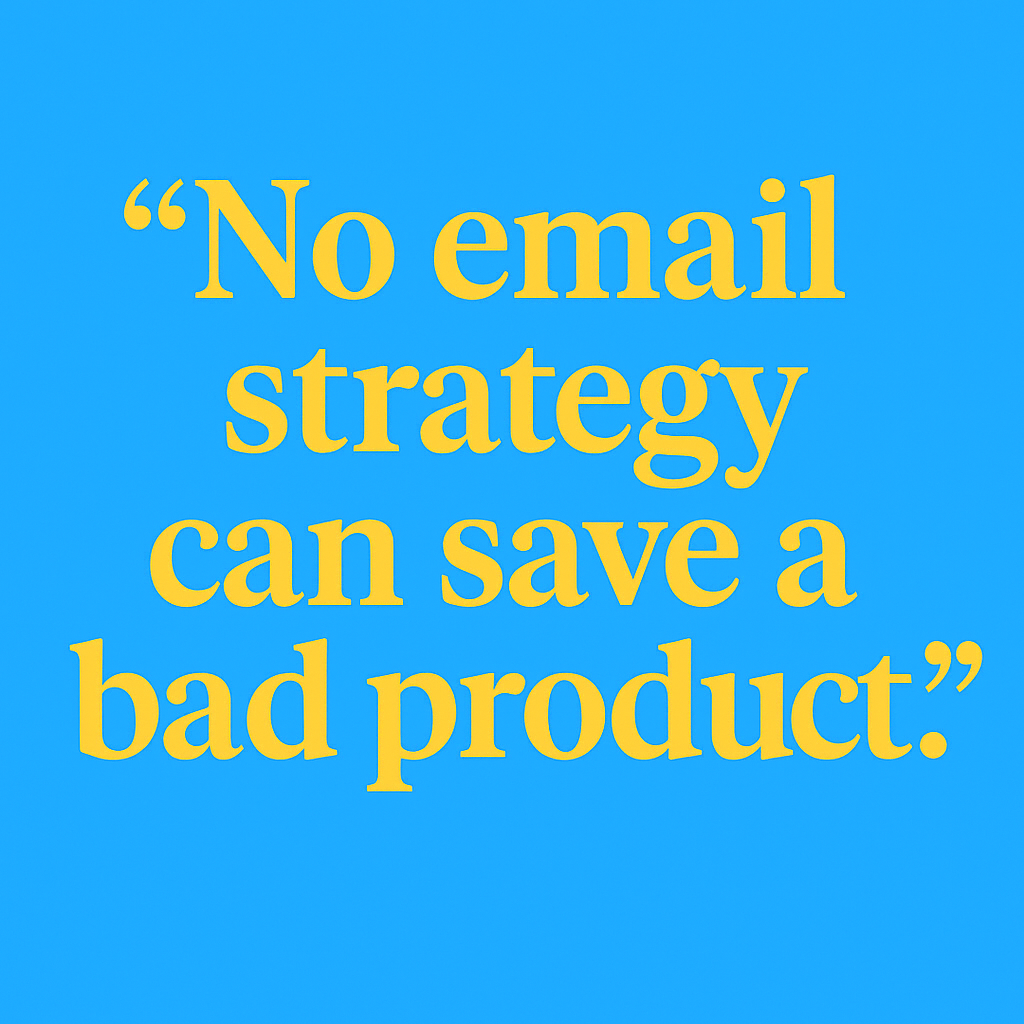
The System
Here’s how we began diagnosing whether the issue was with the email or the offer itself:
Check the Funnel Metrics.
- If opens are strong, the subject line is working.
- If CTR is solid, the copy is working.
- If the placed order rate is weak, the landing page or product is the problem.
Customer Feedback Loop. We started actively collecting feedback: post-purchase surveys, abandoned cart surveys, customer service transcripts. Were people confused about value? Put off by price? Not convinced by the product promise?
Compare Against Benchmarks. If CTR is above industry average but conversion is below, that’s a red flag that interest exists — but belief or desire in the product doesn’t.
Reframe or Rebuild. Sometimes the fix is better positioning (a clearer promise, stronger proof, reframing benefits). Other times, the product itself has to improve.
The Results
The shift was humbling. Instead of endlessly reworking copy, we zoomed out and started having tougher conversations about product-market fit. When the product got better: more value, clearer benefits, easier to use, suddenly the same emails started converting.
This lesson was a reminder: email can’t fix everything. It’s an amplifier. If the product is great, email makes it better. If the product is weak, email just exposes the cracks faster.
5-Minute Fix
Take your last campaign and run the “metrics ladder” check:
- High opens + low clicks = email problem.
- High clicks + low conversions = product/ product page problem.
If the numbers suggest the product is the bottleneck, stop tweaking the copy. Talk to customers. Gather feedback. Ask the hard question: is this product compelling enough to convert interest into action?
Conclusion
Each of these lessons wasn’t learned from a book or a course, they were learned by doing the work. Writing the emails, sending them, watching the numbers rise and fall, and then adjusting.
There are countless fantastic resources out there on email marketing, CRO, and landing pages. I’ve learned a huge amount from them. But for me, the lessons that stick are the ones forged in practice, where theory meets the messy reality of running campaigns for a real business with real customers.
Every brand is different. Every product and service has its quirks, its customer psychology, its unique challenges. What works perfectly in one niche can flop in another. That’s why I don’t believe in “one-size-fits-all” advice.
But I do believe this: if you’ve made it this far, there’s probably at least one lesson here that you can use to make your own emails perform just a little bit better. And in email marketing, those small, consistent improvements add up.
If nothing else, I hope this has shown you that the best lessons don’t just come from reading, they come from doing.
If you read this whole post, you're probably as serious about email as I am. If you're looking for someone to help drive more revenue from email, let's jump on a call.

